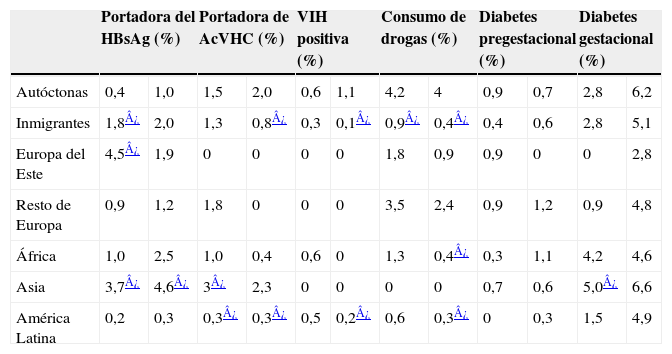Conocer las características de los recién nacidos (RN) de las gestantes inmigrantes atendidas en nuestro medio y compararlas con las de los RN de madre autóctona.
Pacientes y métodosSe incluyen los RN atendidos en la Sección de Neonatología del Hospital del Mar en el período 2007–2008 (n=3.177). Las gestantes inmigrantes se clasificaron en 6 regiones. Se establecieron 12 diagnósticos y se calculó el riesgo relativo (RR) de estos. Se compararon los resultados con los obtenidos en un estudio previo en el período 2003–2004.
ResultadosHubo 1.373 RN autóctonos y 1.743 RN inmigrantes. Las gestantes inmigrantes presentaban mayor incidencia de antígeno de superficie de la hepatitis B (RR de 4,33), riesgo de infección (RR de 1,24) y macrosomia (RR de 1,4). Hubo 6 gestantes inmigrantes con virus de la inmunodeficiencia humana (VIH) positivas frente a 8 españolas. Las gestantes inmigrantes tenían menos incidencia de consumo de drogas (RR de 0,15). No hubo diferencias significativas en el resto de las variables.
En el comparativo entre los 2 períodos observamos un aumento de la inmigración. No persiste el mejor peso al nacimiento en RN inmigrantes que era significativo en el período 2003–2004. Continúa predominando la infección por VIH y por virus de la hepatitis C en autóctonos, aunque con incremento en la población inmigrante, y la infección por virus de la hepatitis B en los inmigrantes y en la etnia gitana.
ConclusionesTendencia a la equiparación de los resultados perinatales en los 2 períodos, persistencia de complicaciones secundarias a un control prenatal inadecuado, menor consumo de drogas y moderado incremento de la infección por VIH y virus de la hepatitis C en la población inmigrante y de infección por virus de la hepatitis B en la población inmigrante y autóctonos de etnia gitana.
To describe the characteristics of immigrant women′s newborns in our environment, and to compare them with those of native women.
Patients and methodsAll newborns attended in the Neonatology Unit of Hospital del Mar in Barcelona, Spain, between January 2007–December 2008 were included (n=3,177). Pregnant immigrant women were classified in six regions. Twelve diagnoses were defined and their relative risks were calculated. The results were compared with the results obtained in a previous study of the period 2003–2004.
ResultsThere were 1,373 native newborns and 1,743 of immigrant origin. Immigrant women showed a higher rate of HBsAg carrier status (RR 4.33), neonatal infection risk (RR 1.24) and also macrosomia (RR 1.4). There were 6 HIV positive pregnant immigrant women compared with 8 Spanish women, and drug abuse was lower in the immigrant group (RR 0.15). There were no significant differences in the rate of other diagnoses. In the comparative rates between both periods there was an increased rate of immigrant women′s newborn. We did not find any differences in the mean birth weight among newborns of immigrant women during both periods of time. HIV and hepatitis C infection remained higher in native pregnant women and hepatitis B infection in immigrant women and gypsy native women.
ConclusionsThe study shows similar results between the two periods with persistence of complications secondary to an inadequate prenatal care, lower drug abuse and moderate increase in HIV and VHC infection in immigrant women and hepatitis B infection in immigrant women and gypsy native women.
Artículo
Comprando el artículo el PDF del mismo podrá ser descargado
Precio 19,34 €
Comprar ahora












